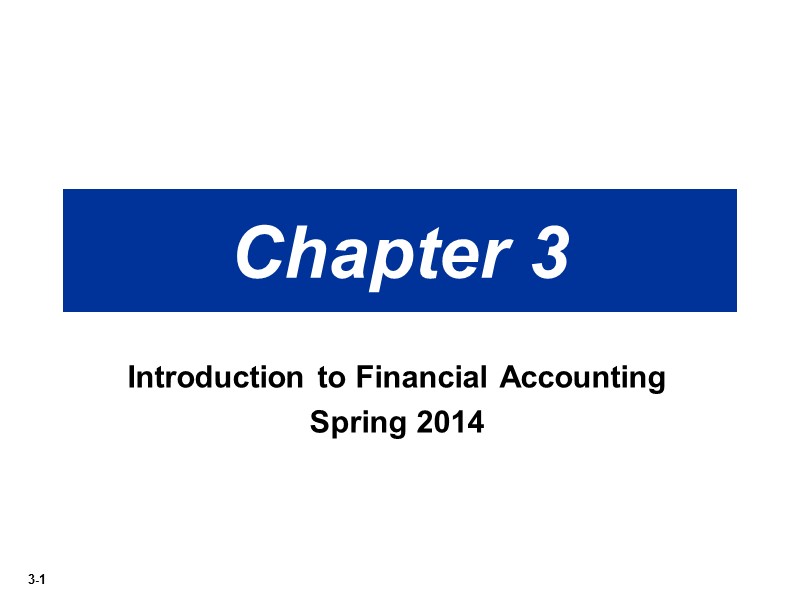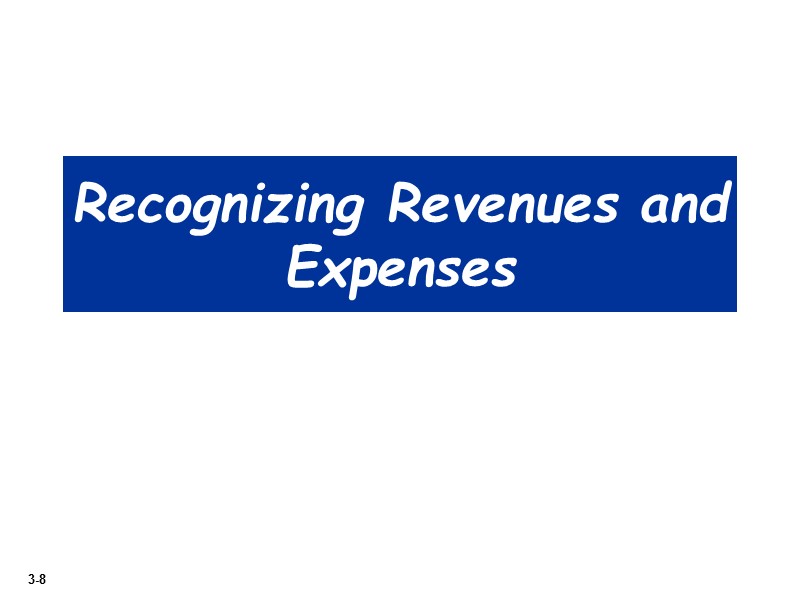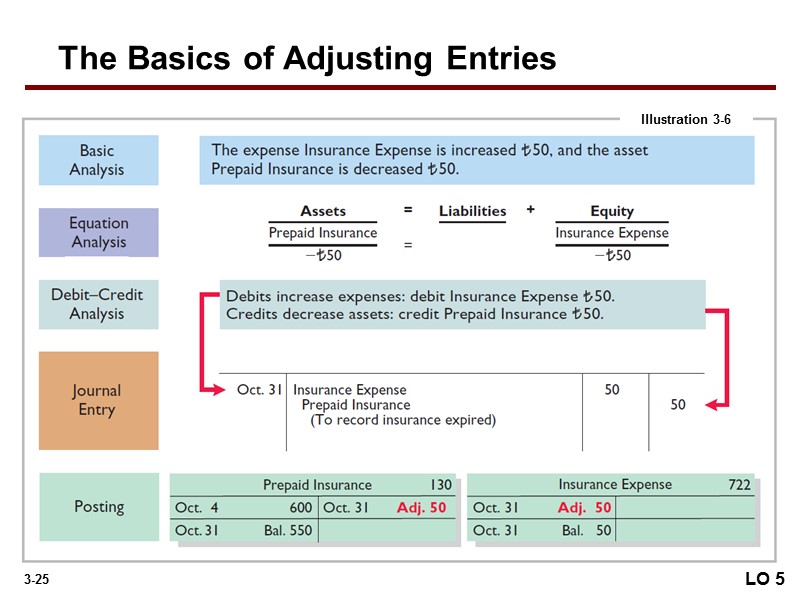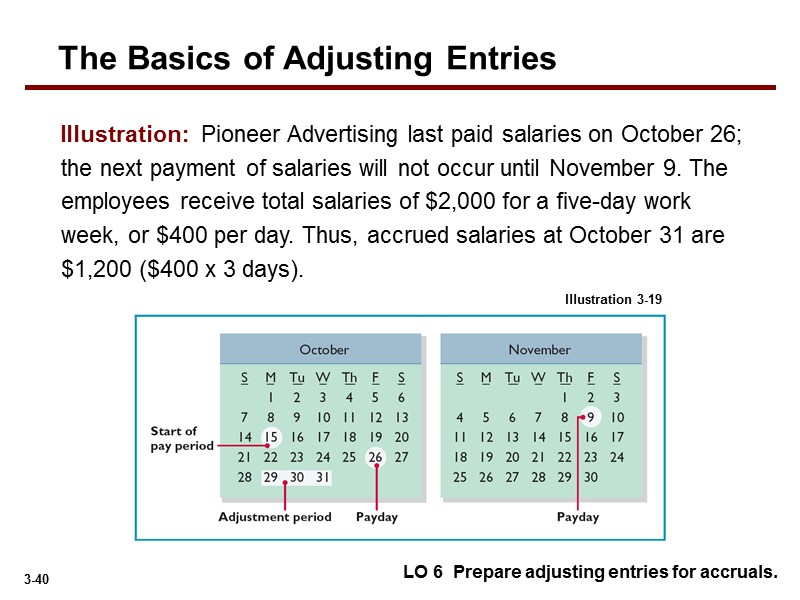Chapter 3 Introduction to Financial Accounting Spring 2014




















































31910-ch03+spring+2014+lje.ppt
- Количество слайдов: 51
 Chapter 3 Introduction to Financial Accounting Spring 2014
Chapter 3 Introduction to Financial Accounting Spring 2014
 Time period assumption
Time period assumption
 Generally a month, a quarter, or a year. Also known as the “Periodicity Assumption” Timing Issues Accountants divide the economic life of a business into artificial time periods (Time Period Assumption). LO 1 Explain the time period assumption. Jan. Feb. Mar. Apr. Dec. . . . . .
Generally a month, a quarter, or a year. Also known as the “Periodicity Assumption” Timing Issues Accountants divide the economic life of a business into artificial time periods (Time Period Assumption). LO 1 Explain the time period assumption. Jan. Feb. Mar. Apr. Dec. . . . . .
 Monthly and quarterly time periods are called interim periods. Most large companies must prepare both quarterly and annual financial statements. Fiscal Year = Accounting time period that is one year in length. Calendar Year = January 1 to December 31. Timing Issues LO 1 Explain the time period assumption. Fiscal and Calendar Years
Monthly and quarterly time periods are called interim periods. Most large companies must prepare both quarterly and annual financial statements. Fiscal Year = Accounting time period that is one year in length. Calendar Year = January 1 to December 31. Timing Issues LO 1 Explain the time period assumption. Fiscal and Calendar Years
 Accrual- and Cash-Basis Accounting
Accrual- and Cash-Basis Accounting
 Accrual-Basis Accounting Transactions recorded in the periods in which the events occur. Revenues are recognized when the services are performed, rather than when cash is received. Expenses are recognized when incurred, rather than when paid. Accrual- vs. Cash-Basis Accounting LO 2 Explain the accrual basis of accounting. Timing Issues
Accrual-Basis Accounting Transactions recorded in the periods in which the events occur. Revenues are recognized when the services are performed, rather than when cash is received. Expenses are recognized when incurred, rather than when paid. Accrual- vs. Cash-Basis Accounting LO 2 Explain the accrual basis of accounting. Timing Issues
 Cash-Basis Accounting Revenues recognized when cash is received. Expenses recognized when cash is paid. Cash-basis accounting is not in accordance with International Financial Reporting Standards (IFRS). Accrual- vs. Cash-Basis Accounting LO 2 Explain the accrual basis of accounting. Timing Issues
Cash-Basis Accounting Revenues recognized when cash is received. Expenses recognized when cash is paid. Cash-basis accounting is not in accordance with International Financial Reporting Standards (IFRS). Accrual- vs. Cash-Basis Accounting LO 2 Explain the accrual basis of accounting. Timing Issues
 Recognizing Revenues and Expenses
Recognizing Revenues and Expenses
 Revenue Recognition Principle Recognizing Revenues and Expenses LO 2 Explain the accrual basis of accounting. Recognize revenue in the accounting period in which the performance obligation is satisfied. In a service enterprise, revenue is considered to be earned at the time the service is performed. Timing Issues
Revenue Recognition Principle Recognizing Revenues and Expenses LO 2 Explain the accrual basis of accounting. Recognize revenue in the accounting period in which the performance obligation is satisfied. In a service enterprise, revenue is considered to be earned at the time the service is performed. Timing Issues
 Expense Recognition Principle Recognizing Revenues and Expenses LO 2 Explain the accrual basis of accounting. Match expenses with revenues in the period when the company makes efforts to generate those revenues. “Let the expenses follow the revenues.” Timing Issues
Expense Recognition Principle Recognizing Revenues and Expenses LO 2 Explain the accrual basis of accounting. Match expenses with revenues in the period when the company makes efforts to generate those revenues. “Let the expenses follow the revenues.” Timing Issues
 Adjusting Entries
Adjusting Entries
 Why are adjusting entries needed? In order for revenues and expenses to be reported in the correct period, companies make adjusting entries at the end of the accounting period. Example: Company A’s fiscal year is January 1, 2012 to December 31, 2012. On December 1, company A paid $1,200 cash in advance for 1 year building insurance policy. Entry on December 1, 2012 Dr.) Prepaid insurance (Asset) 1,200 Cr.) Cash 1,200 What if company A reported $1,200 of prepaid insurance as an asset in the statement of financial position as of December 31, 2012? Do you think that company A accurately report its financial position on December 31, 2012?
Why are adjusting entries needed? In order for revenues and expenses to be reported in the correct period, companies make adjusting entries at the end of the accounting period. Example: Company A’s fiscal year is January 1, 2012 to December 31, 2012. On December 1, company A paid $1,200 cash in advance for 1 year building insurance policy. Entry on December 1, 2012 Dr.) Prepaid insurance (Asset) 1,200 Cr.) Cash 1,200 What if company A reported $1,200 of prepaid insurance as an asset in the statement of financial position as of December 31, 2012? Do you think that company A accurately report its financial position on December 31, 2012?
 Time period assumption 12/1/2012 12/31/2012 Fiscal Year End 12/31/2013 Fiscal Year End 11/30/2013 1 Year insurance policy: including two fiscal years used 1 month 11 months will be used during next fiscal year On December 31, 2012, recognize one month expense and decrease in asset
Time period assumption 12/1/2012 12/31/2012 Fiscal Year End 12/31/2013 Fiscal Year End 11/30/2013 1 Year insurance policy: including two fiscal years used 1 month 11 months will be used during next fiscal year On December 31, 2012, recognize one month expense and decrease in asset
 Adjusting entry for prepaid insurance on fiscal year end Entry on December 31, 2012 Dr.) Insurance expense 100 Cr.) Prepaid insurance 100 Prepaid insurance 12/1 1,200 12/31 100 Bal. 1,100 Insurance expense 12/31 100 Bal. 100
Adjusting entry for prepaid insurance on fiscal year end Entry on December 31, 2012 Dr.) Insurance expense 100 Cr.) Prepaid insurance 100 Prepaid insurance 12/1 1,200 12/31 100 Bal. 1,100 Insurance expense 12/31 100 Bal. 100
 Adjusted trial balance A company must make adjusting entries every time it prepares financial statements
Adjusted trial balance A company must make adjusting entries every time it prepares financial statements
 1. Prepaid Expenses. Expenses paid in cash before they are used or consumed. Deferrals 3. Accrued Revenues. Revenues for services performed but not yet received in cash or recorded. 4. Accrued Expenses. Expenses incurred but not yet paid in cash or recorded. 2. Unearned Revenues. Cash received before services are performed. Accruals Illustration 3-2 Categories of adjusting entries The Basics of Adjusting Entries LO 4 Identify the major types of adjusting entries. Types of Adjusting Entries
1. Prepaid Expenses. Expenses paid in cash before they are used or consumed. Deferrals 3. Accrued Revenues. Revenues for services performed but not yet received in cash or recorded. 4. Accrued Expenses. Expenses incurred but not yet paid in cash or recorded. 2. Unearned Revenues. Cash received before services are performed. Accruals Illustration 3-2 Categories of adjusting entries The Basics of Adjusting Entries LO 4 Identify the major types of adjusting entries. Types of Adjusting Entries
 Trial Balance – Each account is analyzed to determine whether it is complete and up-to-date. Illustration 3-3 The Basics of Adjusting Entries LO 4 Identify the major types of adjusting entries. Types of Adjusting Entries
Trial Balance – Each account is analyzed to determine whether it is complete and up-to-date. Illustration 3-3 The Basics of Adjusting Entries LO 4 Identify the major types of adjusting entries. Types of Adjusting Entries
 Deferrals
Deferrals
 Deferrals are either: Prepaid expenses OR Unearned revenues. LO 5 Prepare adjusting entries for deferrals. Adjusting Entries for Deferrals The Basics of Adjusting Entries
Deferrals are either: Prepaid expenses OR Unearned revenues. LO 5 Prepare adjusting entries for deferrals. Adjusting Entries for Deferrals The Basics of Adjusting Entries
 Payment of cash, that is recorded as an asset because service or benefit will be received in the future. insurance supplies advertising Cash Payment Expense Recorded BEFORE rent equipment buildings Prepayments often occur in regard to: LO 5 Prepare adjusting entries for deferrals. The Basics of Adjusting Entries Prepaid Expenses
Payment of cash, that is recorded as an asset because service or benefit will be received in the future. insurance supplies advertising Cash Payment Expense Recorded BEFORE rent equipment buildings Prepayments often occur in regard to: LO 5 Prepare adjusting entries for deferrals. The Basics of Adjusting Entries Prepaid Expenses
 Expire either with the passage of time or through use. Adjusting entry: Increase (debit) to an expense account and Decrease (credit) to an asset account. LO 5 Prepare adjusting entries for deferrals. The Basics of Adjusting Entries Prepaid Expenses Illustration 3-4
Expire either with the passage of time or through use. Adjusting entry: Increase (debit) to an expense account and Decrease (credit) to an asset account. LO 5 Prepare adjusting entries for deferrals. The Basics of Adjusting Entries Prepaid Expenses Illustration 3-4
 Illustration: Pioneer Advertising Agency purchased supplies costing $2,500 on October 5. Pioneer recorded the payment by increasing (debiting) the asset Supplies. This account shows a balance of $2,500 in the October 31 trial balance. An inventory count at the close of business on October 31 reveals that $1,000 of supplies are still on hand. Supplies 1,500 Supplies expense 1,500 Oct. 31 LO 5 Prepare adjusting entries for deferrals. The Basics of Adjusting Entries
Illustration: Pioneer Advertising Agency purchased supplies costing $2,500 on October 5. Pioneer recorded the payment by increasing (debiting) the asset Supplies. This account shows a balance of $2,500 in the October 31 trial balance. An inventory count at the close of business on October 31 reveals that $1,000 of supplies are still on hand. Supplies 1,500 Supplies expense 1,500 Oct. 31 LO 5 Prepare adjusting entries for deferrals. The Basics of Adjusting Entries
 The Basics of Adjusting Entries Illustration 3-5 LO 5
The Basics of Adjusting Entries Illustration 3-5 LO 5
 Illustration: On October 4, Pioneer Advertising paid $600 for a one-year fire insurance policy. Coverage began on October 1. Pioneer recorded the payment by increasing (debiting) Prepaid Insurance. This account shows a balance of $600 in the October 31 trial balance. Insurance of $50 ($600 ÷ 12) expires each month. Prepaid insurance 50 Insurance expense 50 Oct. 31 LO 5 Prepare adjusting entries for deferrals. The Basics of Adjusting Entries
Illustration: On October 4, Pioneer Advertising paid $600 for a one-year fire insurance policy. Coverage began on October 1. Pioneer recorded the payment by increasing (debiting) Prepaid Insurance. This account shows a balance of $600 in the October 31 trial balance. Insurance of $50 ($600 ÷ 12) expires each month. Prepaid insurance 50 Insurance expense 50 Oct. 31 LO 5 Prepare adjusting entries for deferrals. The Basics of Adjusting Entries
 The Basics of Adjusting Entries Illustration 3-6 LO 5
The Basics of Adjusting Entries Illustration 3-6 LO 5
 Receipt of cash that is recorded as a liability because service has not be performed. Rent Airline tickets Cash Receipt Revenue Recorded BEFORE Magazine subscriptions Customer deposits Unearned revenues often occur in regard to: LO 5 Prepare adjusting entries for deferrals. The Basics of Adjusting Entries Unearned Revenues
Receipt of cash that is recorded as a liability because service has not be performed. Rent Airline tickets Cash Receipt Revenue Recorded BEFORE Magazine subscriptions Customer deposits Unearned revenues often occur in regard to: LO 5 Prepare adjusting entries for deferrals. The Basics of Adjusting Entries Unearned Revenues
 Adjusting entry is made to record the revenue for services performed and to show the liability that remains. Results in a decrease (debit) to a liability account and an increase (credit) to a revenue account. LO 5 Prepare adjusting entries for deferrals. The Basics of Adjusting Entries Unearned Revenues Illustration 3-10
Adjusting entry is made to record the revenue for services performed and to show the liability that remains. Results in a decrease (debit) to a liability account and an increase (credit) to a revenue account. LO 5 Prepare adjusting entries for deferrals. The Basics of Adjusting Entries Unearned Revenues Illustration 3-10
 Illustration: Pioneer Advertising received $1,200 on October 2 from R. Knox for advertising services expected to be completed by December 31. Unearned Service Revenue shows a balance of $1,200 in the October 31 trial balance. Analysis reveals that the company earned $400 of those fees in October. Service revenue 400 Unearned service revenue 400 Oct. 31 LO 5 Prepare adjusting entries for deferrals. The Basics of Adjusting Entries
Illustration: Pioneer Advertising received $1,200 on October 2 from R. Knox for advertising services expected to be completed by December 31. Unearned Service Revenue shows a balance of $1,200 in the October 31 trial balance. Analysis reveals that the company earned $400 of those fees in October. Service revenue 400 Unearned service revenue 400 Oct. 31 LO 5 Prepare adjusting entries for deferrals. The Basics of Adjusting Entries
 The Basics of Adjusting Entries LO 5 Illustration 3-11
The Basics of Adjusting Entries LO 5 Illustration 3-11
 Accruals
Accruals
 Accruals are made to record Revenues for services performed OR Expenses incurred in the current accounting period that have not been recognized through daily entries. Adjusting Entries for Accruals The Basics of Adjusting Entries LO 6 Prepare adjusting entries for accruals.
Accruals are made to record Revenues for services performed OR Expenses incurred in the current accounting period that have not been recognized through daily entries. Adjusting Entries for Accruals The Basics of Adjusting Entries LO 6 Prepare adjusting entries for accruals.
 Revenues for services performed but not yet received in cash or recorded. Interest Services performed Rent Accrued revenues often occur in regard to: The Basics of Adjusting Entries Accrued Revenues LO 6 Prepare adjusting entries for accruals. BEFORE Cash Receipt Revenue Recorded
Revenues for services performed but not yet received in cash or recorded. Interest Services performed Rent Accrued revenues often occur in regard to: The Basics of Adjusting Entries Accrued Revenues LO 6 Prepare adjusting entries for accruals. BEFORE Cash Receipt Revenue Recorded
 Adjusting entry shows the receivable that exists and records the revenues for services performed. Adjusting entry: Increases (debits) an asset account and Increases (credits) a revenue account. The Basics of Adjusting Entries Illustration 3-13 LO 6 Accrued Revenues
Adjusting entry shows the receivable that exists and records the revenues for services performed. Adjusting entry: Increases (debits) an asset account and Increases (credits) a revenue account. The Basics of Adjusting Entries Illustration 3-13 LO 6 Accrued Revenues
 Illustration: In October Pioneer Advertising Agency recognized $200 for advertising services performed but not recorded. Accounts receivable 200 Cash 200 Nov. 10 The Basics of Adjusting Entries LO 6 Prepare adjusting entries for accruals. 200 Service revenue 200 Accounts receivable Oct. 31 On November 10, Pioneer receives cash of $ 200 for the services performed.
Illustration: In October Pioneer Advertising Agency recognized $200 for advertising services performed but not recorded. Accounts receivable 200 Cash 200 Nov. 10 The Basics of Adjusting Entries LO 6 Prepare adjusting entries for accruals. 200 Service revenue 200 Accounts receivable Oct. 31 On November 10, Pioneer receives cash of $ 200 for the services performed.
 The Basics of Adjusting Entries Illustration 3-14 LO 6
The Basics of Adjusting Entries Illustration 3-14 LO 6
 Expenses incurred but not yet paid in cash or recorded. Rent Interest Taxes Salaries Accrued expenses often occur in regard to: The Basics of Adjusting Entries Accrued Expenses BEFORE Cash Payment Expense Recorded LO 6 Prepare adjusting entries for accruals.
Expenses incurred but not yet paid in cash or recorded. Rent Interest Taxes Salaries Accrued expenses often occur in regard to: The Basics of Adjusting Entries Accrued Expenses BEFORE Cash Payment Expense Recorded LO 6 Prepare adjusting entries for accruals.
 Adjusting entry records the obligation and recognizes the expense. Adjusting entry: Increase (debit) an expense account and Increase (credit) a liability account. LO 6 The Basics of Adjusting Entries Accrued Expenses Illustration 3-16
Adjusting entry records the obligation and recognizes the expense. Adjusting entry: Increase (debit) an expense account and Increase (credit) a liability account. LO 6 The Basics of Adjusting Entries Accrued Expenses Illustration 3-16
 Illustration: Pioneer Advertising signed a three-month note payable in the amount of $5,000 on October 1. The note requires Pioneer to pay interest at an annual rate of 12%. Interest payable 50 Interest expense 50 Oct. 31 The Basics of Adjusting Entries LO 6 Prepare adjusting entries for accruals. Illustration 3-17
Illustration: Pioneer Advertising signed a three-month note payable in the amount of $5,000 on October 1. The note requires Pioneer to pay interest at an annual rate of 12%. Interest payable 50 Interest expense 50 Oct. 31 The Basics of Adjusting Entries LO 6 Prepare adjusting entries for accruals. Illustration 3-17
 The Basics of Adjusting Entries Illustration 3-18 LO 6
The Basics of Adjusting Entries Illustration 3-18 LO 6
 Illustration: Pioneer Advertising last paid salaries on October 26; the next payment of salaries will not occur until November 9. The employees receive total salaries of $2,000 for a five-day work week, or $400 per day. Thus, accrued salaries at October 31 are $1,200 ($400 x 3 days). The Basics of Adjusting Entries LO 6 Prepare adjusting entries for accruals. Illustration 3-19
Illustration: Pioneer Advertising last paid salaries on October 26; the next payment of salaries will not occur until November 9. The employees receive total salaries of $2,000 for a five-day work week, or $400 per day. Thus, accrued salaries at October 31 are $1,200 ($400 x 3 days). The Basics of Adjusting Entries LO 6 Prepare adjusting entries for accruals. Illustration 3-19
 The Basics of Adjusting Entries Illustration 3-20 LO 6
The Basics of Adjusting Entries Illustration 3-20 LO 6
 The Basics of Adjusting Entries LO 6 Prepare adjusting entries for accruals. Summary of Basic Relationships Illustration 3-22
The Basics of Adjusting Entries LO 6 Prepare adjusting entries for accruals. Summary of Basic Relationships Illustration 3-22
 Adjusted Trial Balance
Adjusted Trial Balance
 Prepared after all adjusting entries are journalized and posted. Purpose is to prove the equality of debit balances and credit balances in the ledger. Is the primary basis for the preparation of financial statements. LO 7 Describe the nature and purpose of an adjusted trial balance. The Adjusted Trial Balance Adjusted Trial Balance
Prepared after all adjusting entries are journalized and posted. Purpose is to prove the equality of debit balances and credit balances in the ledger. Is the primary basis for the preparation of financial statements. LO 7 Describe the nature and purpose of an adjusted trial balance. The Adjusted Trial Balance Adjusted Trial Balance
 Illustration 3-25
Illustration 3-25
 Financial Statements are prepared directly from the Adjusted Trial Balance. Statement of Financial Position Income Statement Retained Earnings Statement LO 7 Describe the nature and purpose of an adjusted trial balance. Preparing Financial Statements
Financial Statements are prepared directly from the Adjusted Trial Balance. Statement of Financial Position Income Statement Retained Earnings Statement LO 7 Describe the nature and purpose of an adjusted trial balance. Preparing Financial Statements
 LO 7 Illustration 3-26
LO 7 Illustration 3-26
 LO 7 Illustration 3-27
LO 7 Illustration 3-27
 When a company prepays an expense, it debits that amount to an expense account. When a company receives payment for future services, it credits the amount to a revenue account. Alternative Treatment of Prepaid Expenses and Unearned Revenues LO 8 Prepare adjusting entries for the alternative treatment of deferrals. APPENDIX 3A
When a company prepays an expense, it debits that amount to an expense account. When a company receives payment for future services, it credits the amount to a revenue account. Alternative Treatment of Prepaid Expenses and Unearned Revenues LO 8 Prepare adjusting entries for the alternative treatment of deferrals. APPENDIX 3A
 LO 8 Prepare adjusting entries for the alternative treatment of deferrals. Illustration 3A-2 Prepaid Expenses Company may choose to debit (increase) an expense account rather than an asset account. This alternative treatment is simply more convenient. APPENDIX 3A
LO 8 Prepare adjusting entries for the alternative treatment of deferrals. Illustration 3A-2 Prepaid Expenses Company may choose to debit (increase) an expense account rather than an asset account. This alternative treatment is simply more convenient. APPENDIX 3A
 LO 8 Prepare adjusting entries for the alternative treatment of deferrals. Illustration 3A-5 Company may credit (increase) a revenue account when they receive cash for future services. APPENDIX 3A Unearned Revenues
LO 8 Prepare adjusting entries for the alternative treatment of deferrals. Illustration 3A-5 Company may credit (increase) a revenue account when they receive cash for future services. APPENDIX 3A Unearned Revenues

